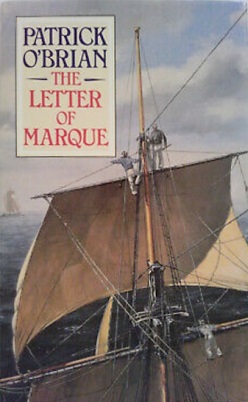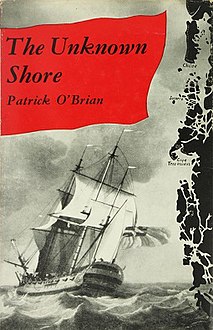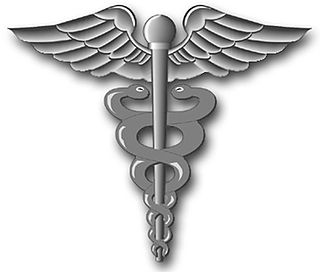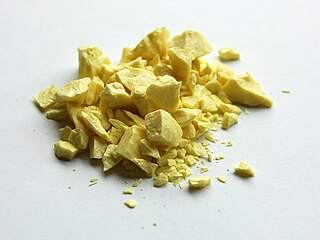
A hospital ship is a ship designated for primary function as a floating medical treatment facility or hospital. Most are operated by the military forces of various countries, as they are intended to be used in or near war zones.

The Mauritius Command is the fourth naval historical novel in the Aubrey-Maturin series by Patrick O'Brian, first published in 1977.

The Fortune of War is the sixth historical novel in the Aubrey-Maturin series by British author Patrick O'Brian, first published in 1979. It is set during the War of 1812.

The Ionian Mission is the eighth historical novel in the Aubrey-Maturin series by Patrick O'Brian, first published in 1981. The story is set during the Napoleonic Wars.

The Far Side of the World is the tenth historical novel in the Aubrey-Maturin series by Patrick O'Brian, first published in 1984. The story is set during the Napoleonic Wars and the War of 1812.

The Letter of Marque is the twelfth historical novel in the Aubrey–Maturin series by Patrick O'Brian, first published in 1988. The story is set during the Napoleonic Wars and the War of 1812.

The Commodore is the seventeenth historical novel in the Aubrey-Maturin series by British author Patrick O'Brian, first published in 1995. The story is set during the Napoleonic Wars and the War of 1812.

The Wine-Dark Sea is the sixteenth historical novel in the Aubrey-Maturin series by British author Patrick O'Brian, first published in 1993. The story is set during the Napoleonic Wars and the War of 1812.

Clarissa Oakes is the fifteenth historical novel in the Aubrey-Maturin series by British author Patrick O'Brian, first published in 1992. The story is set during the Napoleonic Wars and the War of 1812.

In the rating system of the British Royal Navy used to categorise sailing warships, a sixth-rate was the designation for small warships mounting between 20 and 28 carriage-mounted guns on a single deck, sometimes with smaller guns on the upper works and sometimes without. It thus encompassed ships with up to 30 guns in all. In the first half of the 18th century the main battery guns were 6-pounders, but by mid-century these were supplanted by 9-pounders. 28-gun sixth rates were classed as frigates, those smaller as 'post ships', indicating that they were still commanded by a full ('post') captain, as opposed to sloops of 18 guns and less under commanders.

HMAS Hobart was a modified Leander-class light cruiser which served in the Royal Australian Navy (RAN) during World War II. Originally constructed for the Royal Navy as HMS Apollo, the ship entered service in 1936, and was sold to Australia two years later. During the war, Hobart was involved in the evacuation of British Somaliland in 1940, fought at the Battle of the Coral Sea and supported the amphibious landings at Guadalcanal and Tulagi in 1942. She was torpedoed by a Japanese submarine in 1943, then returned to service in 1945 and supported the landings at Tarakan, Wewak, Brunei, and Balikpapan. Hobart was placed in reserve in 1947, but plans to modernise her and return her to service as an aircraft carrier escort, training ship, or guided missile ship were not followed through. The cruiser was sold for scrapping in 1962.

The Unknown Shore is a novel published in 1959 by Patrick O'Brian. It is the story of two friends, Jack Byron and Tobias Barrow, who sail aboard HMS Wager as part of the voyage around the world led by Anson in 1740. Their ship did not make it all the way around the world, unlike the flag ship. The novel is a fictionalised version of actual events which occurred during the Wager Mutiny.

A hospital corpsman (HM) is an enlisted medical specialist of the United States Navy, who may also serve in a U.S. Marine Corps unit. The corresponding rank within the United States Coast Guard is Health Services Technician (HS).

Sir William Beatty was an Irish surgeon who served in the Royal Navy. Born in Derry, Ireland, he joined as a surgeon's mate in 1791 at the age of 18. He is best known as the Ship's Surgeon aboard HMS Victory during the Battle of Trafalgar, at which he witnessed the death of Admiral Horatio Nelson, and for authoring an account of that battle – The Death of Lord Nelson.
Seafaring is a tradition which encompasses a variety of professions and ranks. Each of these roles carries unique responsibilities which are integral to the successful operation of a seafaring vessel. A ship's crew can generally be divided into four main categories: the deck department, the engineering department, the steward's department, and other. The reasoning behind this is that a ship's bridge, filled with sophisticated navigational equipment, requires skills differing from those used on deck operations – such as berthing, cargo and/or military devices; which in turn requires skills different from those used in a ship's engine room and propulsion, and so on.
This is a list of recurring characters in the Aubrey–Maturin series of novels by Patrick O'Brian. As is noted in the articles about each novel, some of these characters are based on real historical persons, while others are purely fictional. Because there is an article describing each novel, links are made to those articles when mentioning the stories in which each character appears. References to page numbers, where they appear, are based upon the W. W. Norton & Company printing of the novels.

The Sick and Hurt Commissioners were responsible for medical services in the Royal Navy. They were a separate body to the Navy Board, supplying surgeons to naval ships, providing them with medicines and equipment, and running shore and ship hospitals; they were also responsible for prisoners of war.

The master, or sailing master, was a historical rank for a naval officer trained in and responsible for the navigation of a sailing vessel. The rank can be equated to a professional seaman and specialist in navigation, rather than as a military commander.






















